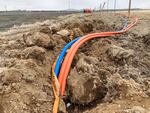Hermiston has a potential solution to rural Oregon’s digital divide. Rather than waiting for a private company to bolster its high-speed internet, the city could just build the broadband infrastructure itself.
It’s an idea being explored by Hermiston city staff, who are not only looking at connecting every home and business to high-speed internet, but the cities and unincorporated areas that surround Hermiston as well.
At an April meeting, Hermiston Energy Services Superintendent Nate Rivera told the City Council that the local government could finance the project with a broadband grant created by the federal Infrastructure Investment and Jobs Act.

Fiber-optic cables being laid in Grant County in this 2022 file photo are aimed at providing more broadband access in the community. The state has been providing assistance to rural areas in recent years, aiming to increase broadband access.
Kristian Foden-Vencil / OPB
Although Hermiston does have high speed internet service providers, Rivera said not every neighborhood in Hermiston is connected. A city analysis showed that about 60% of the city’s households and businesses do not meet federal high-speed standards.
Rivera said the advantage of Hermiston owning its own broadband network is its availability and accessibility, comparing it to the public road system.
“We’re not incentivizing a private company to build a single access point,” he said. “We’re building and owning our own network to offer everybody access. We’re building digital roads in our community that any business can operate on. We don’t pick who operates on those. But we own the infrastructure, maintain the infrastructure and manage how it’s invested and maintained.”
A publicly owned, regional broadband network isn’t the only option on the table. Rivera said Hermiston could go it alone and build a public network solely for Hermiston residents, or it could go through the private sector. An internet service provider has already expressed interest in connecting homes and businesses throughout Hermiston with higher internet speeds, Rivera said. But, that network would be owned by the provider rather than the public.
The regional network would be more ambitious. It will connect to Hermiston, as well as the cities of Umatilla, Stanfield and Echo, and the unincorporated areas that surround them. Rivera said he expects the proposed network could have 1 gigabyte download per second speeds, 40 times faster than the 25 megabyte per second speed found in much of Hermiston. He also expects it to be affordable, projecting users’ monthly cost at $35 per month.
Hermiston city manager Byron Smith said all of this would be done without competing directly with existing providers. While Hermiston would build and own the broadband infrastructure, the responsibility of connecting consumers to the internet would still lie with private internet service providers.
“You can have FedEx and UPS competing to deliver packages because they all have our road to drive on,” he said. “That same could be for (internet service providers) Charter and Blue Mountain Networks, and an ISP that’s located in North Carolina or somewhere else. They could provide internet service over our network and maybe they can do it at a cheaper price than our local providers.”

In some parts of rural Oregon, communities have experimented with providing technology as a means of retaining high-tech workers like Ryne Smith. In this 2022 file photo, Smith uses the high-speed, reliable internet access at Seneca's new CyberMill cafe, opened with the help of a county grant.
Kristian Foden-Vencil / OPB
Hermiston’s idea is novel but not unprecedented.
City staff pointed to Ammon, Idaho, a town of about 18,000 in eastern Idaho. Ammon started building its own broadband network in 2011 and by 2023, the city had nine providers charging customers roughly $30 per month.
Rivera said the plan does come with risks. The city would take on the costs of overseeing the broadband network and generating the revenue needed to maintain the project, which relies on providers agreeing to join the network rather than continuing to use their own.
Despite the risks, the council told Rivera to continue exploring the regional network concept. If Hermiston gets other local governments on board, he said he could apply for the broadband infrastructure grant by early next year.
